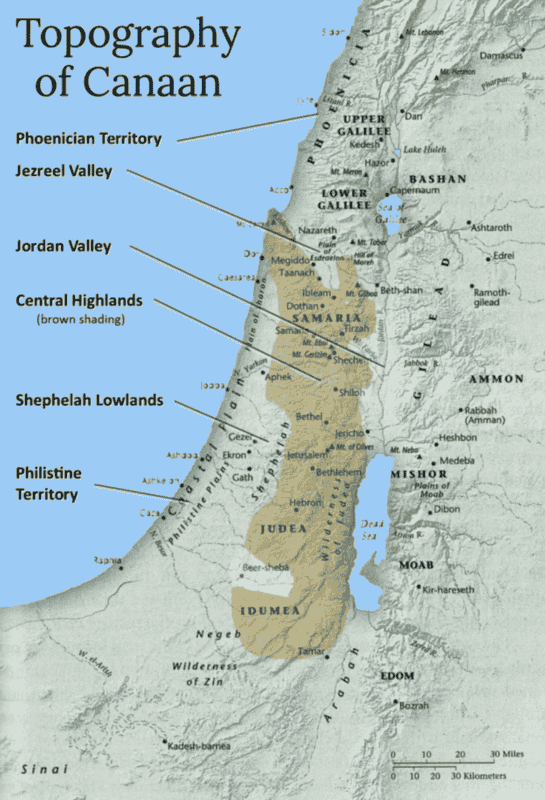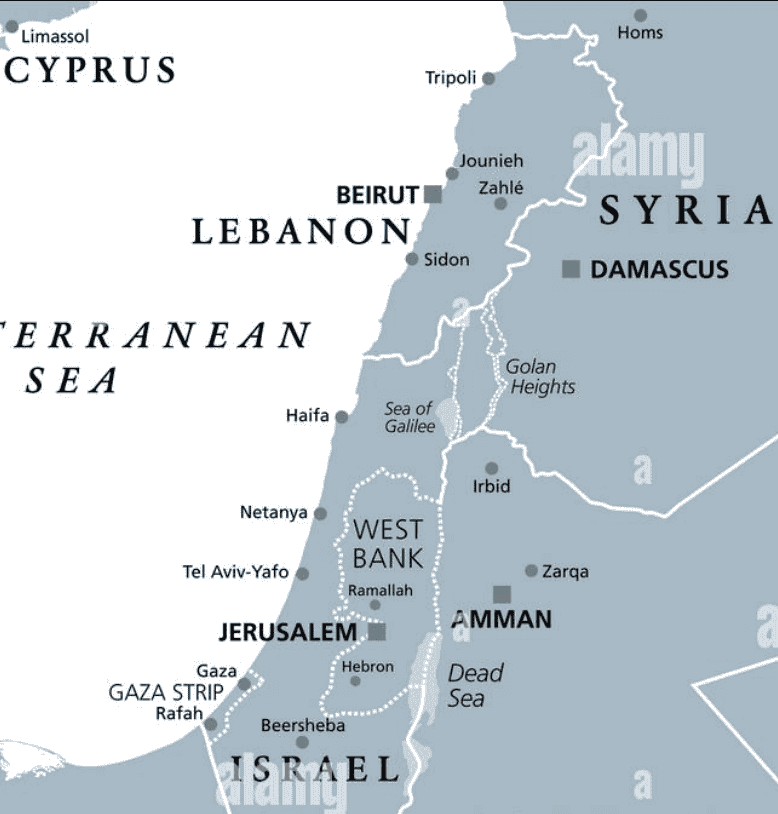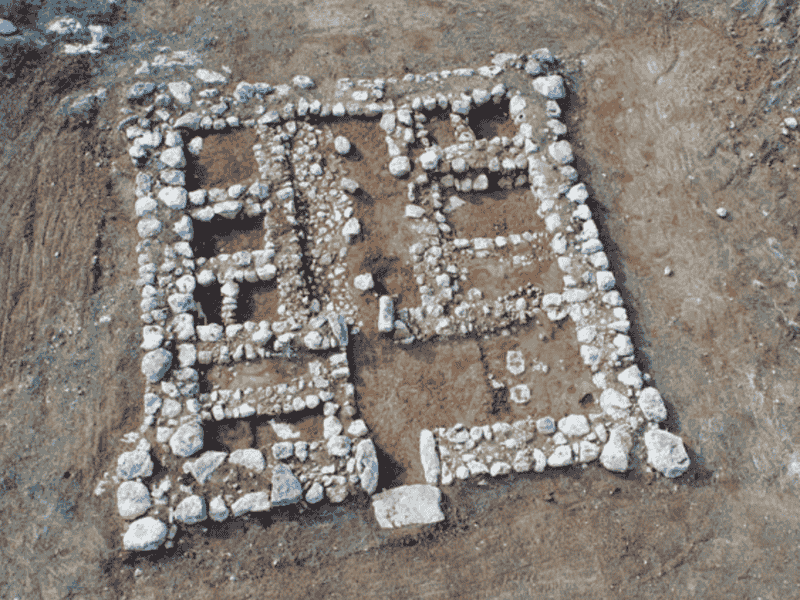What Was Ancient Canaan?
Canaan was a very important place a long time ago. It is often mentioned in the Bible. The land of Canaan was home to many different groups of people called the Canaanites. This land was promised to Abraham and his descendants by God. Learning about where was Canaan helps us understand why it is still important today.
Who were the Canaanites?
The Canaanites built cities, traded with their neighbors, and worshiped different gods. Even after being taken over by other groups like the Egyptians and Israelites, the Canaanites left behind a lot of ideas about farming, building, and writing that still influence us today.
Geographical Location of Ancient Canaan
A long time ago, Canaan was a land on the eastern side of the Mediterranean Sea.

The map of ancient Canaan shows a region along the eastern Mediterranean coast that includes key biblical areas such as Samaria, Judea, and Idumea, shaded in brown to represent the Central Highlands.
It highlights important topographical zones like the Jordan Valley, Shephelah Lowlands, Philistine Territory, and Phoenician Territory, along with major cities such as Jerusalem, Hebron, Bethel, Shechem, and Beersheba.
Surrounding Canaan are regions like Ammon, Moab, and Edom, showing how Canaan bordered present-day Jordan and Egypt.
The map illustrates Canaan as a land of strategic valleys, mountains, and coastlines, making it a central and contested area in ancient Near Eastern history.
Get Closer to God Today
4.9
Average Rating
|Over 5 Million Downloads
Modern-Day Equivalents: Where Is Canaan Today?
If you look at a map today, modern-day Canaan would cover parts of Israel, Palestine, Lebanon, Syria, and Jordan.

When people ask where Canaan was, they want to know that it included cities like Jericho, Hebron, and Sidon, which still exist today.
If you are wondering where is Canaan today, it is in parts of:
- Israel
- Palestine
- Lebanon
- Syria
- Jordan
The land of Canaan today includes cities like Jerusalem, Hebron, and Gaza. Coastal cities like Tyre and Sidon, now in Lebanon, were part of it too. Even though thousands of years have passed, Canaan today is still a place full of history and faith.
The Meaning and Origin of the Name "Canaan"
The name Canaan is one of the oldest place names known from the ancient world. It appears in some of the earliest historical records, including Egyptian texts, Akkadian writings, and, of course, the Bible. Scholars believe that the word "Canaan" likely comes from a term meaning "lowland" or "land of purple" - referring either to the region’s geography or its famous purple dye trade.
In ancient languages like Hebrew and Phoenician, the root word "kana" can mean "to bend down" or "to be humbled," possibly describing the low-lying coastal areas where many Canaanite cities developed. Other scholars suggest that Canaan may be linked to the word for purple because the people of Canaan, especially the Phoenicians, were known for producing a valuable purple dye from sea snails, an item highly prized in ancient trade.
The Bible uses the name Canaan often, starting with the descendants of Noah’s son Ham (Genesis 10:6) and continuing as the name of the land promised to Abraham. Egyptian texts from as early as the 18th century BCE also mention "the land of Canaan," showing that it was recognized by neighboring civilizations as a distinct and important region.
Over time, Canaan became more than just a geographic label. It symbolized a land of promise, conflict, and rich cultural exchange. Even today, when we talk about where Canaan was or where it is today, the name carries deep historical, religious, and cultural meaning that connects the ancient world to the present.
Biblical Significance of Canaan
In the Bible, Canaan is not just a land; it’s a central part of God’s promises and the story of His people. When God called Abraham, He directed him to the land of Canaan, saying:
"To your offspring I will give this land." - Genesis 12:7 (NIV)
This land, later known as the Promised Land, was where Abraham, Isaac, and Jacob would live. So when people ask, was Canaan the promised land, the answer is yes. It was the land given by God to the ancestors of the Israelites.
Later, during the time of Moses, God reminded the Israelites of this promise:
"So I have come down to rescue them from the hand of the Egyptians and to bring them up out of that land into a good and spacious land, a land flowing with milk and honey - the home of the Canaanites..." - Exodus 3:8 (NIV)
This verse shows how Canaan was seen as a rich and fertile land, ready to become the home of a free people. After their escape from Egypt, the Israelites wandered in the desert for 40 years. Their goal was always to reach the land of Canaan, where they would finally settle as a nation.
The Book of Joshua tells the story of how the Israelites entered Canaan:
"So Joshua took the entire land, just as the Lord had directed Moses, and he gave it as an inheritance to Israel." - Joshua 11:23 (NIV)
This moment fulfilled God’s long-standing promise. It’s one of the most important turning points in the Bible. Cities such as Jericho, Ai, Hebron, and Bethel - many of which are shown on the map of ancient Canaan - became key parts of Israelite history.
When people search for where is Canaan in the Bible or where was Canaan, they are usually trying to trace these powerful stories. They want to connect the places on the page with real lands - places that still exist today in modern day Canaan, such as Israel and Palestine.
So, Canaan in the Bible is more than geography. It’s a land of promises kept, faith tested, and a home finally gained.
Get Closer to God Today
4.9
Average Rating
|Over 5 Million Downloads
Cultural and Political Context: Canaan in Today's World
Understanding Canaan today isn’t just about ancient cities and Bible stories, it also means looking at how this historic land fits into the modern world. The area once known as the land of Canaan now overlaps with several present-day nations: mostly Israel and Palestine, but also parts of Lebanon, Syria, and Jordan. This region remains one of the most culturally rich and politically complex places on Earth.
Historically, Canaan was a place where many groups lived together: Canaanites, Philistines, Phoenicians, Israelites, and others. These people had different languages, customs, and religions. Today, the region still reflects that mix. The modern population includes Jews, Christians, and Muslims, as well as many ethnic and cultural groups with deep roots in the area. This diversity connects directly to the ancient past, when Canaan was a crossroads of trade, religion, and migration.
However, this land is also at the heart of serious political conflict. The question of who controls it, who belongs there, and how borders are drawn has led to decades of tension, especially between Israel and Palestine. For this reason, when people refer to Canaan Palestine or Canaan Palestine Israel, they are often exploring not only history, but also current events, identity, and national claims.
Despite the conflict, Canaan today continues to be a place of incredible cultural value. Sacred sites in Jerusalem, Hebron, Nazareth, and Bethlehem attract millions of visitors. Museums and archaeological digs bring ancient Canaanite history to life. Farmers still work in valleys like the Jordan Valley, and cities like Gaza and Jericho are home to communities that have lived there for generations.
So while modern-day Canaan is not an official country, its legacy is still very real. It lives on through culture, faith, memory, and debate. It remains a symbol of promise, but also of the challenges that come with sharing a land that means so much to so many.
Historical Maps and Archaeological Findings
Archaeologists have found many items from the time of the Canaanites. Old maps, like the Old Testament map of Middle East, show Canaan as a land with many towns and farms. Digging in places like Hazor, Megiddo, and Lachish has shown us cities with walls, streets, and homes. Some maps even show Ancient Egypt map Palestine, connecting Canaan to other famous ancient lands.

Canaanite fortress near Gal On in central Israel
One amazing new discovery is the 3,200-year-old Canaanite fortress found near Gal On in central Israel. This fortress was built during a time described in the Book of Judges, when the Canaanites, Israelites, and Philistines were fighting for control of the land. According to archaeologists from the Israel Antiquities Authority, the land of Canaan at that time was ruled by the Egyptians, who worked with the Canaanites to hold onto their territory.
Through both old maps and exciting new discoveries, we can see how Canaan was a land full of strong cities, rich culture, and constant struggle, much like the complicated world we know today.
Conclusion: The Legacy of Canaan Today
When we ask where is Canaan today, the answer is that it is still here, just in different countries like Israel, Palestine, Lebanon, Syria, and Jordan. Canaan is not just a place on the map; it is a part of history that shaped the world. Learning about Canaan helps us see how the past still affects us today.
Get Closer to God Today
4.9
Average Rating
|Over 5 Million Downloads
Frequently Asked Questions (FAQ) about Canaan
1. Where is Canaan today?
Today, Canaan would be located in parts of Israel, Palestine, Lebanon, Syria, and Jordan. These modern countries cover the same general area that was once known as the land of Canaan.
2. Was Canaan the Promised Land?
Yes, Canaan was the land promised by God to Abraham and his descendants, as described in the Bible. So when we ask, was Canaan the promised land, the answer is clearly yes. It is often called the Promised Land in biblical stories.
3. What happened to the land of Canaan?
Over time, the land of Canaan changed hands many times. It was first ruled by the Canaanites, then controlled by Egyptians, Israelites, and later by various empires like the Babylonians and Romans. Today, the ancient cities and cultures of Canaan have become part of the rich history of the Middle East.
4. Who were the Canaanites?
The Canaanites were the original people living in the land of Canaan. They had their own languages, religions, and cities. Archaeologists have found many items, including pottery and fortresses, that show the Canaanites were skilled builders and traders.
5. Is there any archaeological evidence of Canaan?
Yes! Archaeologists have discovered many ancient sites across modern day Canaan. Recently, a 3,200-year-old Canaanite fortress was found near Gal On in Israel. Other famous sites include Jericho, Hazor, and Megiddo, where remains of Canaanite cities have been uncovered.
6. Where was Canaan in the Bible?
In the Bible, Canaan is mentioned often as the land God promised to Abraham and later to the Israelites. When people ask where was Canaan, they are usually referring to areas that today include Israel and Palestine, along with parts of neighboring countries.
7. Is Canaan the same as Israel?
Not exactly. Canaan was a larger region that included what is now Israel, but also parts of Palestine, Lebanon, Syria, and Jordan. After the Israelites settled in Canaan, part of the land became the Kingdom of Israel.
References
Sci News, Archaeologists Unearth Canaanite Fortress in Central Israel, https://www.sci.news/archaeology/gal-on-canaanite-fortress-08778.html, accessed 29th April 2025.
The Holy Bible, New International Version (NIV). Zondervan, 2011.
Image Sources:
https://www.historyinthebible.com/supplementary_pages/simple-map.html
https://www.alamy.com/israel-and-sinai-peninsula-gray-political-map-southern-levant-encompassing-israel-palestine-jordan-lebanon-southern-syria-and-the-sinai-image568562277.html?imageid=153D0782-94D9-49FA-9B4D-AC177979F8CC&p=183153&pn=1&searchId=377b991796ec979ad5f3e19d527e4e39&searchtype=0









